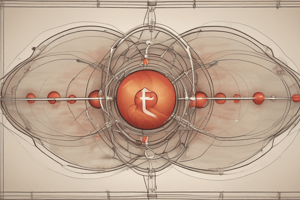Podcast
Questions and Answers
What is the meaning of the German word 'Aufbau'?
What is the meaning of the German word 'Aufbau'?
- Breaking down
- Energy level
- Electron filling
- Building up (correct)
In the Aufbau principle, which energy level is filled first?
In the Aufbau principle, which energy level is filled first?
- 3s
- 2s
- 2p
- 1s (correct)
What is the maximum number of electrons an orbital can hold in the Aufbau principle?
What is the maximum number of electrons an orbital can hold in the Aufbau principle?
- 2 (correct)
- 3
- 4
- 1
What determines when to stop adding electrons in the Aufbau principle?
What determines when to stop adding electrons in the Aufbau principle?
What is the sequence of filling orbitals in the Aufbau principle?
What is the sequence of filling orbitals in the Aufbau principle?
What is the significance of the Aufbau principle?
What is the significance of the Aufbau principle?
Flashcards are hidden until you start studying
Study Notes
Aufbau Principle
Definition
The Aufbau principle is a method used to determine the electronic configuration of an atom in its ground state.
Key Concepts
- Aufbau: German for "building up" or "construction"
- Based on the idea that electrons occupy the lowest available energy levels in an atom
- Used to determine the electron configuration of an atom in its ground state
How it Works
- Start with the lowest energy level: Begin with the 1s orbital, which has the lowest energy
- Add electrons one by one: Each subsequent electron is added to the lowest available energy level
- Follow the Pauli Exclusion Principle: Each orbital can hold a maximum of 2 electrons with opposite spins
- Fill orbitals in order of increasing energy: The order of filling orbitals is:
- 1s, 2s, 2p, 3s, 3p, 4s, 3d, 4p, 5s, 4d, 5p, ...
- Stop when the atom is neutral: The process stops when the atom has the same number of electrons as protons
Example
- Hydrogen (H): 1 electron, 1s1
- Helium (He): 2 electrons, 1s2
- Lithium (Li): 3 electrons, 1s2 2s1
Importance
The Aufbau principle is essential in understanding the electronic structure of atoms and how it relates to the periodic table. It helps explain the periodic trends and properties of elements.
Aufbau Principle
Definition
- A method used to determine the electronic configuration of an atom in its ground state.
Key Concepts
- Means "building up" or "construction" in German.
- Based on the idea that electrons occupy the lowest available energy levels in an atom.
- Used to determine the electron configuration of an atom in its ground state.
How it Works
- Starts with the lowest energy level, which is the 1s orbital.
- Electrons are added one by one to the lowest available energy level.
- Each orbital can hold a maximum of 2 electrons with opposite spins (Pauli Exclusion Principle).
- Orbitals are filled in order of increasing energy: 1s, 2s, 2p, 3s, 3p, 4s, 3d, 4p, 5s, 4d, 5p, and so on.
- The process stops when the atom has the same number of electrons as protons, making it neutral.
Examples
- Hydrogen (H) has 1 electron, with an electron configuration of 1s1.
- Helium (He) has 2 electrons, with an electron configuration of 1s2.
- Lithium (Li) has 3 electrons, with an electron configuration of 1s2 2s1.
Importance
- Essential in understanding the electronic structure of atoms and its relation to the periodic table.
- Helps explain periodic trends and properties of elements.
Studying That Suits You
Use AI to generate personalized quizzes and flashcards to suit your learning preferences.




